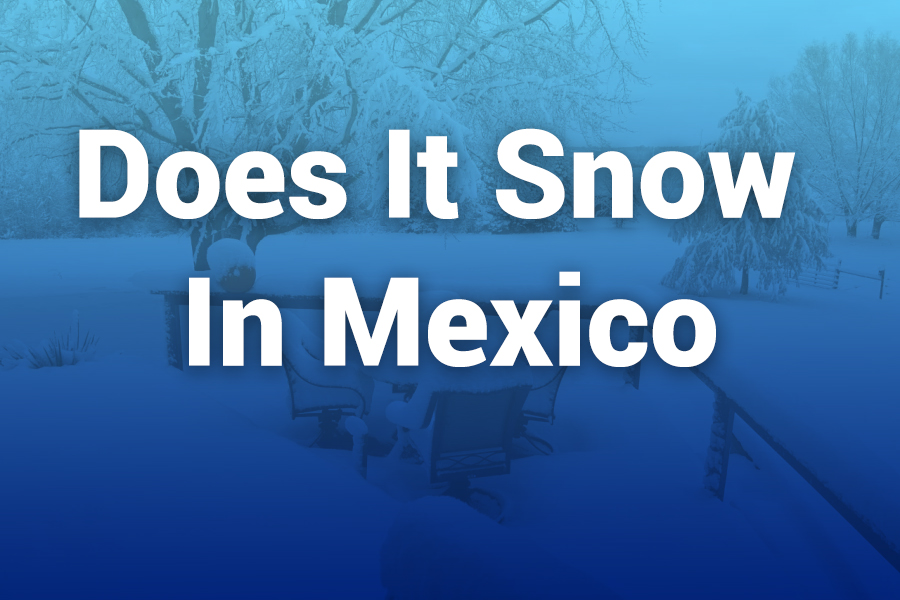
Mexico is famous for its sunny beaches, tropical resorts, and warm desert landscapes, but many people are surprised to learn that snow actually falls in several regions across the country. While the idea of snow in Mexico might seem unusual, this diverse nation has a wide range of climates influenced by altitude and geography.
From the peaks of the Sierra Madre Mountains to the high-altitude cities like Toluca and Mexico City, winter can bring stunning white landscapes and chilly temperatures. In this article, you’ll learn exactly where it snows in Mexico, what months experience the most snowfall, and why altitude plays a crucial role in shaping Mexico’s unique weather patterns.
Understanding Mexico’s Diverse Climate
Mexico’s geography spans deserts, jungles, coasts, and high mountains. This variation gives rise to a wide range of climates—from tropical and arid to alpine and temperate. Most of Mexico experiences warm or hot weather throughout the year, but in elevated regions, temperatures drop significantly during winter.
According to the Köppen climate classification, Mexico includes tropical, subtropical, and temperate zones. The country’s southern region, including Yucatán, Chiapas, and Oaxaca, enjoys tropical weather year-round. However, as you move toward central and northern Mexico, elevation becomes a defining factor. Cities at higher altitudes such as Toluca (8,700 feet above sea level) and Puebla (7,200 feet) regularly experience colder winters that occasionally bring snow.
Altitude: The Key Factor Behind Snow in Mexico
Mexico’s climate diversity is largely driven by altitude rather than latitude. Although the country sits within tropical latitudes, elevation makes a dramatic difference. Areas below 3,000 feet (900 meters) stay warm throughout the year, but once you climb above 7,000 feet (2,100 meters), temperatures can drop near or below freezing during the winter months.
The highest mountains in Mexico—like Pico de Orizaba, Popocatépetl, and Iztaccíhuatl—rise well above 17,000 feet (5,000 meters) and remain snow-covered almost year-round. These peaks are part of the Trans-Mexican Volcanic Belt, stretching across the center of the country. Mountaineers and tourists often visit these sites for a rare glimpse of permanent snow in a tropical nation.
Regions in Mexico Where It Snows
While not every region of Mexico sees snow, several areas experience annual or occasional snowfall.
- Central Mexico (Mexico City, Toluca, Puebla)
Mexico City, the country’s capital, rarely gets snow, but its nearby volcanoes do. Popocatépetl and Iztaccíhuatl, located near the capital, have snow at their peaks for much of the year. In Toluca, located at an altitude of about 8,700 feet, snow occasionally falls in winter, especially around the Nevado de Toluca volcano. Puebla, another high-altitude city, can also experience cold fronts that bring frost and rare snow. - Northern Mexico (Chihuahua, Durango, Coahuila)
The northern states have more extreme temperature swings. In Chihuahua, Durango, and Coahuila, winter nights can drop below freezing, and snowfall is common in elevated regions. Chihuahua City and Creel, part of the Sierra Tarahumara range, often experience snow during December and January. Durango’s mountains can also see several inches of snow per year, creating a scenic winter landscape unlike the typical desert image of Mexico. - Volcanic Peaks and High Mountains (Pico de Orizaba, Popocatépetl, Iztaccíhuatl)
These iconic volcanic mountains are Mexico’s snowiest areas. Pico de Orizaba, the tallest peak in Mexico at over 18,400 feet (5,636 meters), is covered in snow throughout the year. Climbers report snow depths reaching several feet even in summer. Popocatépetl and Iztaccíhuatl, located between Mexico City and Puebla, are also snow-capped year-round, though volcanic activity can occasionally affect snowfall patterns. - Western and Northwestern Regions (Baja California and Sierra Madre Occidental)
In Baja California, particularly near the Sierra de San Pedro Mártir National Park, snowfall occurs during winter months, especially at elevations above 8,000 feet. The Sierra Madre Occidental range, which extends across western Mexico, also receives snow in its highest parts, particularly in the states of Sonora and Sinaloa.
When Does It Snow in Mexico?
Snowfall in Mexico typically occurs between December and February, coinciding with the Northern Hemisphere’s winter. In some high mountain regions, light snow can fall as early as November or as late as March.
In northern states like Chihuahua, snowstorms can occur once or twice a year, often lasting a few days. In central Mexico, snow is rarer, usually limited to high volcanic peaks. On these mountains, temperatures drop below freezing even during the day, maintaining snow cover for extended periods.
Average Winter Temperatures by Region
- Northern Mexico: Daytime temperatures range from 40°F to 60°F (4°C to 15°C), while nights can drop below freezing.
- Central Mexico: Daytime temperatures remain around 55°F to 70°F (13°C to 21°C), but mornings can fall to 32°F (0°C) in high-altitude towns.
- Southern Mexico: Average temperatures stay mild, between 70°F and 85°F (21°C to 29°C), with no chance of snow.
These figures show how Mexico’s elevation dramatically impacts temperature and weather patterns.
Does Mexico City Get Snow?
Snow in Mexico City is extremely rare due to its basin geography and surrounding mountains that block cold air. Historical records show only a few instances of measurable snowfall in the city itself—the most famous one occurred in January 1967, when snow briefly blanketed parts of the capital. However, nearby mountain peaks, just an hour’s drive away, still get regular snowfall in winter.
Snow Tourism in Mexico
While most tourists flock to Mexico for sun and sand, winter enthusiasts also find attractions in snowy destinations. Several spots offer scenic winter getaways:
- Nevado de Toluca National Park: Visitors can hike or drive up to the crater lakes and sometimes witness snowfall during December and January.
- Pico de Orizaba National Park: Mountaineers travel from around the world to climb Mexico’s highest peak, experiencing snow even in summer.
- Sierra de Arteaga (Coahuila): Known as “Mexico’s little Switzerland,” this region transforms into a snow-covered retreat in winter.
- Copper Canyon (Chihuahua): Snow-dusted cliffs and pine forests make this one of Mexico’s most photogenic winter spots.
Winter sports such as mountaineering, hiking, and photography thrive in these cold regions. Although Mexico doesn’t have established ski resorts like those in the U.S. or Canada, the snowy mountain trails offer plenty of adventure for nature lovers.
Why Coastal Mexico Never Sees Snow
Mexico’s coastal regions, including Cancun, Tulum, Mazatlán, and Acapulco, never experience snow because of their low elevation and tropical climate. These areas remain warm and humid all year, with winter temperatures averaging around 75°F to 85°F (24°C to 29°C). Even during cold fronts, ocean influence keeps the air far too warm for snow formation.
Cities such as Cancun, Playa del Carmen, and Mérida have never recorded snow in history. Their tropical rainforests and beaches define the warm-weather image most people associate with Mexico.
How Elevation and Geography Shape Mexico’s Weather
Mexico’s complex topography influences more than just snowfall. Its mountain ranges—the Sierra Madre Oriental, Sierra Madre Occidental, and Sierra Madre del Sur—form natural barriers that affect rainfall and temperature patterns. For example, the northern highlands often experience dry cold air from the U.S., while the southern regions remain warm and humid under Caribbean and Pacific influences.
This geographic diversity means that on the same winter day, a traveler could surf in Baja California and see snow in the mountains of Chihuahua—all within a few hours of travel.
Recent Weather Trends and Snowfall Data
According to Mexico’s National Meteorological Service, unusual snowfall events have become more noticeable in the past two decades. For example, in January 2021, northern states including Chihuahua and Sonora experienced widespread snow due to Arctic cold fronts pushing south. In February 2023, temperatures in parts of Coahuila and Durango dropped below 20°F (-6°C), creating temporary snow cover.
However, Mexico’s overall trend remains one of warm winters for most regions, with snow restricted to high-altitude areas. Climate scientists note that the combination of altitude and occasional Arctic fronts is the primary cause of Mexico’s limited snowfall.
Can You Experience a White Christmas in Mexico?
Yes, but only in select places. Towns like Arteaga, Creel, and parts of Durango or Toluca may see snow near Christmas time. Families living in these highlands sometimes enjoy “white Christmas” moments, though it’s not a nationwide event. Meanwhile, most of the country celebrates under mild or tropical winter weather.
Fun Facts About Snow in Mexico
- Pico de Orizaba is Mexico’s only glacier-bearing mountain.
- Snow in Mexico City has been recorded fewer than five times in 150 years.
- Chihuahua holds the record for the heaviest snowfalls in modern Mexican history.
- The Mexican word for snow is “nieve,” which also happens to mean “ice cream” in casual use.
Tips for Tourists Visiting Snowy Mexico
If you plan to explore Mexico’s snowy regions, keep these tips in mind:
- Dress in layers and bring insulated jackets for high-altitude travel.
- Drive cautiously, as mountain roads can be icy.
- Check local forecasts—conditions can change rapidly at higher elevations.
- Bring proper footwear for hiking or walking on snow.
Conclusion: A Country of Climate Contrasts
So, does it snow in Mexico? Absolutely—but only in the right places and at the right elevations. Mexico is a nation of extraordinary contrasts, where you can experience tropical beaches, desert heat, and snowy mountain peaks all within the same country. From the permanently white caps of Pico de Orizaba to the occasional flurries in Chihuahua, Mexico’s weather proves that the country’s beauty lies in its diversity.
For travelers, this means endless opportunities: bask in the sun along the Riviera Maya, then chase snow in the highlands for a completely different adventure. Understanding where and why it snows in Mexico reveals not just weather facts but also the incredible geographic richness of one of the world’s most fascinating nations.







